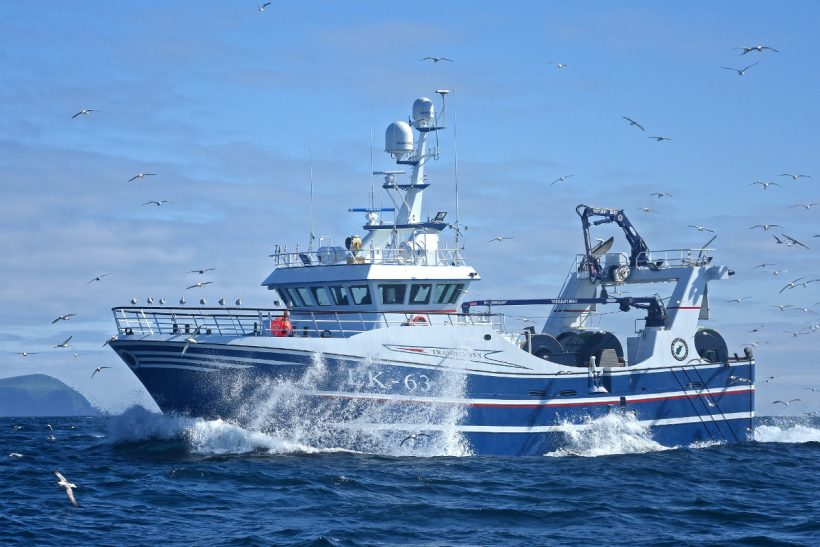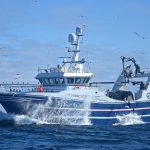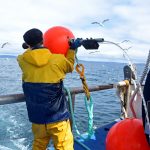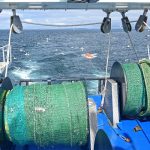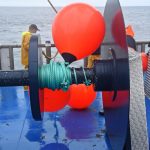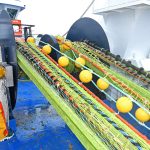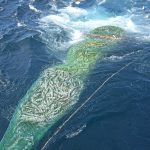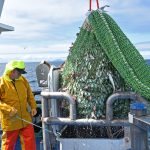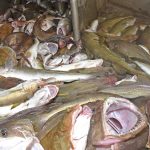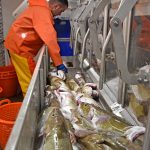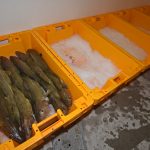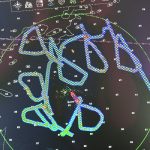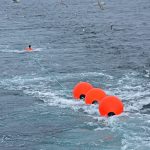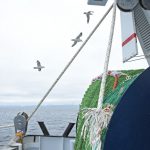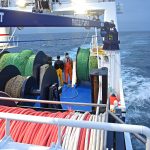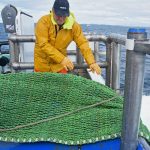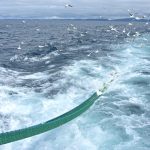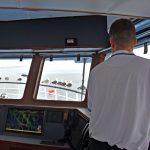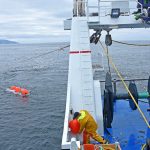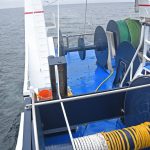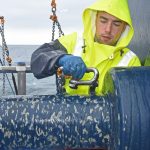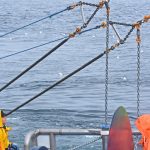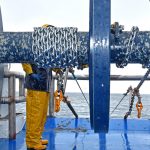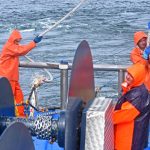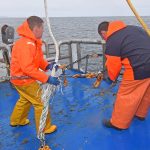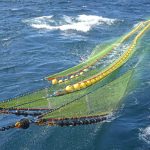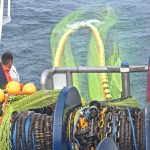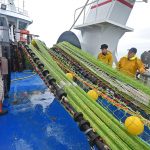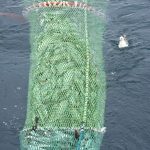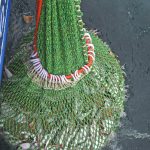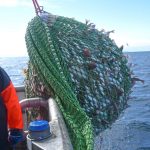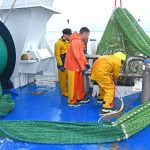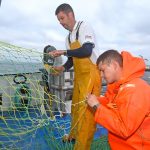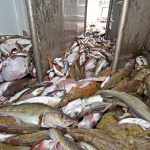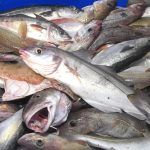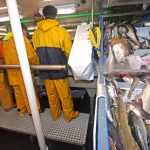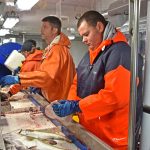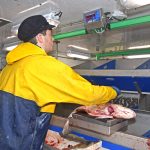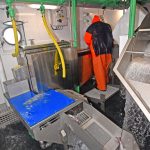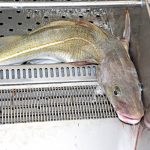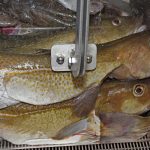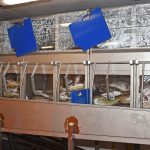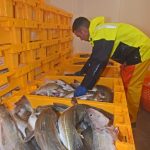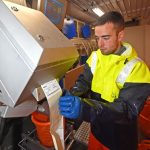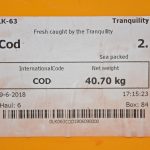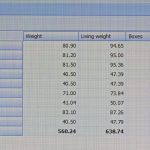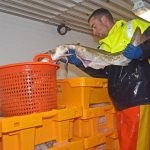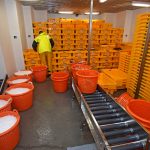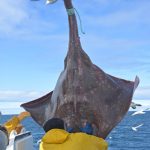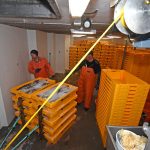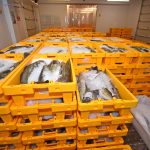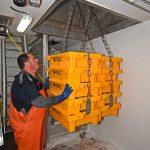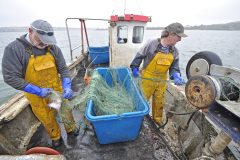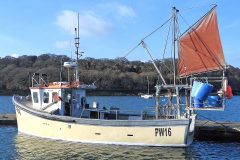The new Whalsay fly-shooter Tranquility LK 63 fished her maiden trip last month, in the Burra Haaf on the west side of Shetland
There was a tangible buzz of anticipation as the crew gathered in Tranquility’s forward messdeck a few minutes into a Saturday morning, in preparation for the start of their maiden trip, reports David Linkie
With the summer solstice less than two weeks away, the ‘simmer dim’, for which Shetland is renowned, meant that the sky over Lerwick was still grey, rather than jet black.
After Chris Shearer started Tranquility’s Mitsubishi S6U (680kW @ 1050rpm) main engine, the sound of which was barely discernible in the wheelhouse, skipper Stuart Anderson carried out a quick check of the wheelhouse equipment, before calling Lerwick port control for clearance to leave harbour, as the crew prepared to throw the ropes off.
Ten minutes later, the flash of Bressay lighthouse slipped astern to port as Tranquility headed due south, parallel to the east coast of Shetland, retracing the route driven four hours earlier on the way north from Sumburgh airport to Lerwick.
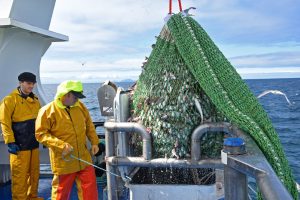
John Johnson prepares to release the codline.
Fishing News had been unable to be in Whalsay the previous weekend, when Tranquility arrived home from Denmark, where the seine-netter was built to a new in-house design by Vestværftet ApS at Hvide Sande (Fishing News, 28 June), so alternative options were discussed with Stuart Anderson as the skippers and crew finished rigging out their new boat at Lerwick.
A WhatsApp message on Thursday morning – “We’re going aff shortly after Friday midnight, with a 95% chance of landing on Sunday. There’s a bed for you” – presented a unique opportunity too good to miss, providing travel arrangements could be made. The tight timescale meant that the usual overnight ferry was not an option, but fortunately Loganair still had seats available on the last flight of the day from Aberdeen, so the much-appreciated offer was quickly confirmed.
On rounding Sumburgh Head, skipper Rodney Reid, who had the watch, set a course into the north-west where the Burra Haaf awaited. Named after Burra Isle, which for generations has been a fishing stronghold in Shetland, the Burra Haaf grounds are a deep, sandy/muddy basin that extends for some 10 miles east/west and four miles north/south, varying in depth from 75 fathoms in the middle to 60 fathoms on the edges. Down the years, they have consistently yielded reliable catches of mainly whiting and haddock, together with a general mix of flats and other whitefish, to a large number of Shetland boats, including up to a dozen Burra Isle seiners. Before Hamnavoe pier was built and Burra was connected to the Shetland mainland by road bridge, these were anchored offshore overnight.
Shetland crews have a longstanding affinity with seine-netting. Today, six of the 21 Shetland whitefish boats are fly-shooters. This total also accounts for 50% of seine-net boats in the Scottish and UK fleet, illustrating the enduring popularity of this fishing method, which is renowned for yielding premium-quality fish.
While power reels first arrived in Shetland 10 years ago, on the new Radiant Star LK 71, and were duplicated two years ago on the Whalsay whitefish boat Resilient LK 195, the design and layout of Tranquility breaks new ground for Shetland.

Hauling the wings of the net onto the starboard drum.
At 4am, Tranquility’s modern style of AIS winkie dahn, followed by three large bluffs, was dropped over the transom with intent for the first time, before starting to run the port rope.
From the power reel mounted on the shelterdeck amidships, the ropes have a straight lead aft to fixed and adjustable hanging blocks mounted on the underside of the gantry, before leading down to a sheave on the gunwale rail. Fifteen coils of 46mm-diameter four-strand combination rope are spooled on each power reel. This equates to a rope length of 3,300m.
As the port rope continued to run, the crew shot away the codend and the tunnel section of the semi-clean ground net. With three coils left, Tranquility came round to port by some 60° to start the second leg of the shot across the tide, just 10 minutes after dropping the dahn, which was now over 2,600m astern. As the last few fathoms of rope came off the barrel, followed by a Dyneema pennant, the net was shot trawl-style off the starboard split net drum, with the headline floats and ground gear running cleanly, followed by 50m of rubber leg and 16mm combination sweep.
When the Dan Leno spreaders came clear of the drum, they were clipped into the end of the ropes with G-links, before the chain pennants were self-released off the drum. As the weight came onto the second set of ropes, the hydraulically-operated brakes continued to be applied to the starboard power reel, as Tranquility towed the starboard wing for 30 to 40 seconds to open up the mouth of the net. With skippers and crew satisfied that all was in order, the brakes were released as the starboard rope started to run. With three coils gone, Tranquility again came to port to start the third leg and complete the traditional seine-net triangular shot, after shooting 660m of rope either side of the net on the second leg.
Tranquility’s crew had shot the 1,220-mesh combi clean net, made by Egersund Trawl Denmark (formerly Thyborøn Trawlbinderi). The net is set on 4in-, 5in- and 6in-diameter rubbers, and rigged with 18mm Dyneema double headline that keeps the floats in line. Twenty-millimetre combination is used for the fishing line. The top wings are made from 3mm Euroline netting, increasing to 4mm Euroline 100mm half mesh in the bottom wings.
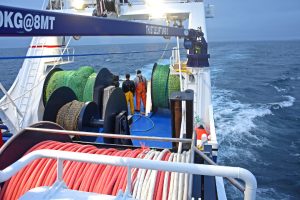
Shooting away for the first time.
On a cracking summer’s morning, the dahn, as well as the all-important lie of the buoys, soon became visible against the instantly recognisable backdrop of Foula. At the same time, its location was constantly displayed on the plotters.
Approaching the dahn, it was immediately obvious that the forward wing consoles in Tranquility’s wheelhouse provided the skippers with an excellent line of sight at all times. As the dahn passed down the starboard side to amidships, a crewman was waiting to throw the traditional grapnel to pick up the end. When the dahn was aboard and unclipped, a messenger rope, previously passed forward around the outside of the gantry leg, was used to take the buoys onto the net drum, before the end of the rope, which was hanging vertically in the water, was clipped in to the Dyneema pennant on the port power reel.
After towing the gear for a few minutes, the power reels started turning, as the first turns of rope began to be spooled onto the barrel. At this point, the Tranquility was around 1.5 miles ahead of the net. Depending on water depth and tide run, an estimated 75-80% of the rope can be on the bottom, thereby maximising the herding effect that seine-netting relies on. During hauling, the boat generally moves about one mile ahead.
In the wheelhouse, all eyes were understandably focused on the display for the customised computer system, designed in-house by Thyborøn Skibs and Motor A/S, that controls the power reels and keeps the gear square. Although this is a completely new ball-game for skippers Stuart Anderson and Rodney Reid, they appeared fairly relaxed and reasonably confident as the layers of rope slowly started to build up. This can largely be attributed to the fact that, after landing their last trip with their previous boat, Tranquility’s skippers and crew spent time at sea on the Wick seiner Boy Andrew, to familiarise themselves with these new working arrangements, an opportunity for which they are very grateful.
The Three J’s auto-system provides a constant display of hauling speed, hydraulic pressure, tension, rope length, and the differential between port and starboard warps. When the selected differential is exceeded, the reel on the longer side is automatically slowed down, in order to keep the port and starboard ropes level in the water astern, before reverting to the chosen rate. The system also caters for four modes of operation – towing, stopped, heaving and shooting.
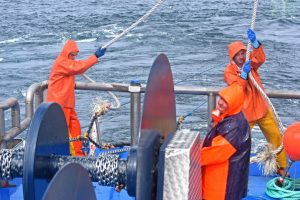
Pulling back slack on the ropes.
Operating at the usually-preferred constant reel speed, the power reels were turning at 10 revolutions per minute. This means that initially the ropes are heaved at a rate of 12-15m per minute, slowly gathering speed towards 55m/min as the diameter of rope on the core increases.
As hauling commenced, the system indicated a rope tension of 3.8t, which gradually decreased to just over 1t during the shot. Running at a constant 1050rpm, with the main hydraulic system being driven by two load-sensing pumps on the gearbox, the 2,780mm-diameter CP propeller was turning at 131rpm with 39% pitch when using 65 litres an hour.
When the ropes close up and the net is no longer fishing, typically with over 1,500m of rope on the reels, heave mode is employed for faster hauling, before the last few coils come in at up to 200m per minute.
During hauling, the ropes lead over the first set of fixed hanging blocks onto a second set of moveable blocks, mounted on the underside of the stern gantry, which are positioned remotely from the fishing console in the wheelhouse. This arrangement enables the skippers to select and adjust the optimum towing position for the gear, in relation to the prevailing tide and weather conditions.
Just over an hour after starting to heave up, the power reels were slowed as the Dan Lenos neared the hanging blocks. Free-hanging chain pennants were then placed over the self-release hooks on either half of the split net drum. After the spreaders were carefully guided on, they were quickly followed by the sweeps and the wings of the net, in a continuous process that concluded with the bag being dried up. On clipping in the Gilson, the codend was quickly lifted up at the starboard quarter, and lowered towards the reception hopper for release.
Happy that all had gone smoothly with the first shot, which yielded a lift of good-quality whitefish, the crew immediately retied the codline before the dahn was dropped for the next shot, a berth to the west. Familiarising themselves with the new working arrangements and establishing efficient working procedures was the primary aim of the first day’s fishing, although, of course, filling boxes would also be welcome.
As the port rope started to run, it was time for the crew to put the catch-handling system through its initial test.
Raising the hydraulically-operated vertical sliding door of the reception hopper enabled the first fish to move onto the elevated conveyor, which delivers them onto the main transverse selection and gutting conveyor arranged across the beam.
Tranquility is the latest in a succession of new whitefish vessels in the Scottish fleet to be equipped with a highly-automated whitefish handling and electronic catch-management system, designed and fabricated by VCU of Urk.
Two large revolving stainless steel drums, with horizontal axes, housed in watertight troughs arranged forward of the fish selection conveyor, provide the initial focus of this system.
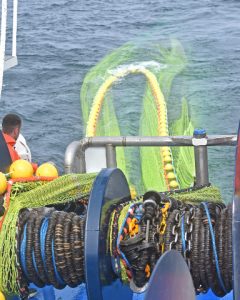
Hauling the wings
Both independently-operated drums are divided into nine sections; three each, transversely and radially. This arrangement allows the crew to place their initial selections into one of six compartments for washing. As the drum rotates in a downward and forward direction, fish are raised clear of the water to slide down separate chutes into six vertical hoppers positioned directly below, against the engineroom bulkhead.
In addition to the six main compartments in the drums, the crew place less frequent selections of other fish into elevated bins, from which they are released into the main system directly below, when this is empty.
A further three selections of fish were also made into a trough between the gutting conveyor and the selection drums, for delivery to a KM MK II gutting machine positioned towards the vessel’s starboard side and operated by Chris Shearer.
Two sets of Marel electronic scales, adjacent to the gutting conveyor, quickly came into play. A relatively new idea, and one that is now used on a number of whitefish boats, this enables the crew to grade fish by gutted weight, rather than by size. The end result is that buyers can purchase fish of a predetermined weight – ie over 6kg, 3-4kg, etc – secure in the knowledge that this will give a consistent fillet yield, closely aligned to their requirements.
Within a few minutes, the first fish were ready for release from the clear-fronted hoppers in the fishroom for weighing and labelling using VCU’s in-house electronic catch-management system, from which information is automatically transferred to a PC in the wheelhouse, where it is accumulated to provide a running total of Tranquility’s trips.
Although the first box of fish appeared isolated and almost insignificant in Tranquility’s fishroom, which has a working capacity of around 1,100 boxes, it was soon joined by others as Robbie Jamieson built up the first tier of boxes forward.
On being weighed, baskets of fish are slid forward along the length of the fishroom on a continuous run of rollers. As the number of tiers increases, the forward sections of rollers are gradually removed.
The capabilities of both the catch-management system and the hold man quickly became clear as weights for part-baskets were entered and stored, before being aggregated when the next supply of the same selection became available. A box weight and label were then printed off.
Fishing progressed smoothly during the first day, in which a further eight shots were made. Stuart Anderson and Rodney Reid swapped wheelhouse and deck duties haul about, each of which were completed, as regular as clockwork, at two-hour intervals.
After 20 boxes were put down from the first go, similar results prevailed for the rest of the day, ranging from mid-teens to low twenties. This gave a total of 133 boxes for the day, which was well-received by all, especially as everything had gone smoothly, apart from a relatively small tear on the sixth haul, which after being quickly laced up, was mended by the skippers after the last shot.
Although cod generally predominated, there was also a consistent showing of haddock, plaice, lemons and coley, along with smaller numbers of hake, megrim and monkfish. At the same time as highlighting the mixed fishery Shetland whitefish boats continue to rely on, this also demonstrated the level of whitefish stocks in Shetland waters, in a trip during which Tranquility was never more than 12 miles from land.
After lying overnight, the crew were called at 4am ahead of the first shot. Fishing in the same area, this gave another slack lift of 20 boxes. The best haul for the shakedown trip came two shots later with 31 boxes, including a good show of haddock.
The fifth and penultimate shot of a shorter day saw a large ‘barn door’ in the form of a blue skate flapping its way down the tunnel section towards the bag. On being released from the net into the hopper, a strop was immediately attached to its tail before it was lifted up by the Gilson and dropped over the side to swim away unharmed.
Another 30 boxes in the last haul took the tally for the day to 157 boxes, and the total for the first trip to 290 boxes, which the crew started to land into Scalloway fishmarket less than two hours after the last fish was taken aboard.
This feature was only made possible by all who contributed to transport and accommodation logistics, and, of course, the skippers and crew of Tranquility. Grateful thanks to all.
Gallery
This feature is intended to show the fishing and catch-handling arrangements on Tranquility. To show the full sequence of operations in images, it has been necessary to use the most appropriate photos taken over the course of the two-day trip, rather than in actual chronological order from any one shot.



